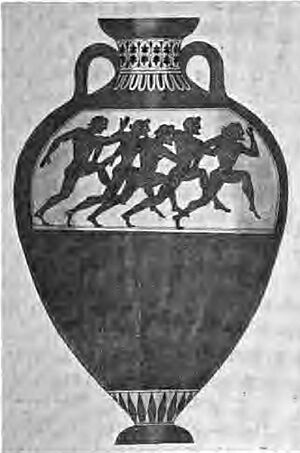Footrace on a Panathenaic Amphora facts for kids
The Footrace on a Panathenaic Amphora shows an ancient Greek footrace. This artwork is on a special clay pot called an amphora. It was made around 530 BC by an artist known as the Euphiletos Painter. This amphora is about 62 centimeters (24.5 inches) tall.
This type of amphora was a prize for winners of the Panathenaic Games, which were held every four years in Athens, Ancient Greece. The pot would have been filled with olive oil from sacred olive trees in Athens. Today, you can see this amazing piece of history at the Metropolitan Museum of Art in New York City.
Contents
What is a Panathenaic Amphora?
Special Prizes for Ancient Games
Panathenaic amphoras were not just any pots. They were official prizes given to champions at the Panathenaic Games. These games were a huge festival in Athens, honoring the goddess Athena. Imagine winning a big sports event and getting a giant jar of valuable olive oil as your trophy!
How They Were Made
These prize amphoras all had a similar shape and could hold a lot of olive oil – about 40 liters (42 quarts). Artists decorated them using a style called the black-figure technique. This meant they painted figures in black silhouette against the red clay, then added details by scratching lines into the black paint.
What the Amphora Shows
On the front of every Panathenaic amphora, there was always a picture of the goddess Athena, ready for battle. On the back, artists painted a scene from the sport that the winner had competed in. This particular amphora shows five men and one young person running in a footrace.
The Art of the Footrace Amphora
Details of the Runners
If you look closely at the runners on this amphora, you can see many fine lines carved into the black figures. These lines show the muscles of the athletes. Ancient Greek artists loved to show the human body in great detail, and this was a big focus for them for hundreds of years.
A Special Signature
This amphora is even more unique because it has an inscription on the front. This writing not only confirms that the vase was a prize, but it also includes the signature of the potter, Nikias. It was very rare for potters to sign their work on these prize amphoras, making this one extra special!


